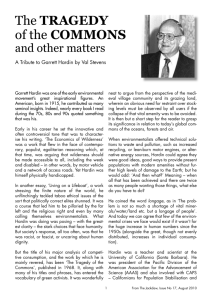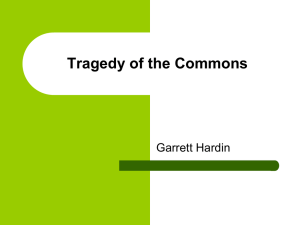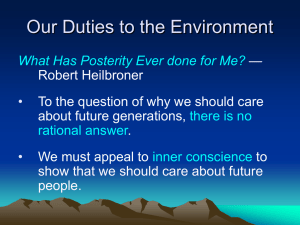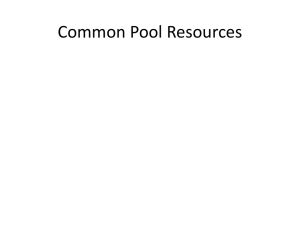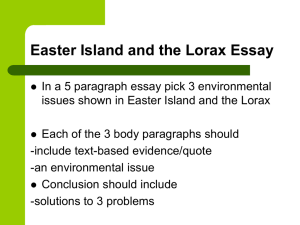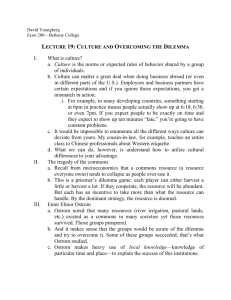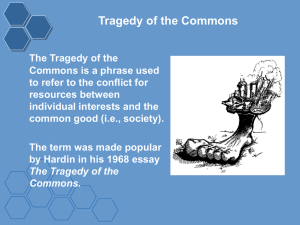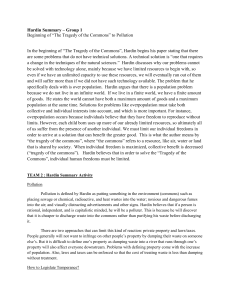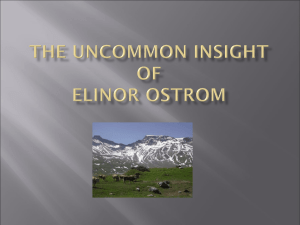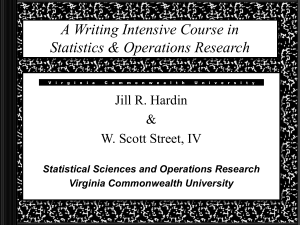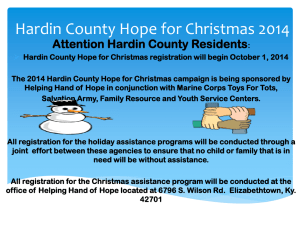Notes
advertisement
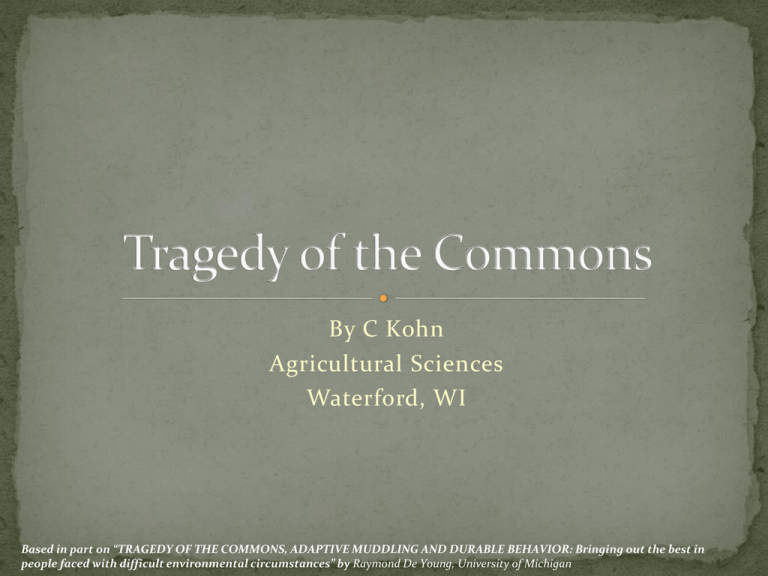
By C Kohn Agricultural Sciences Waterford, WI Based in part on “TRAGEDY OF THE COMMONS, ADAPTIVE MUDDLING AND DURABLE BEHAVIOR: Bringing out the best in people faced with difficult environmental circumstances” by Raymond De Young, University of Michigan Imagine a pond that has been overlooked by the DNR. If all the people in the area knew that the DNR did not check this pond and did not check to see if people took more fish than the legal limit, what would happen to the fish population in this pond? Why might people take more fish from an unchecked, unregulated pond than from one that is regularly monitored by a government agency? Will this happen every time a common resource (such as a pond) is not regulated by the government? Discuss In 1968, an ecologist named Garret Hardin published a work titled “The Tragedy of the Commons” in the research journal Science. In his article, Hardin describes a hypothetical situation involving a pasture open to all farmers. This is known as a “commons”, or a resource available to all people to use that is not owned by any particular person. Hardin describes this commons as a place where multiple farmers are allowed to graze their animals. Each farmer gains more personally as they graze more and more animals. The more animals a farmer grazes, the more they gain personally. In Hardin’s hypothetical grazing situation, because each farmer gains more personally with each animal they add to this pasture, the pasture eventually becomes overgrazed. Each farmers tries to graze as many animals as they can. Because of this, there are simply too many animals on this pasture. Ultimately, the pasture is destroyed, all of the animals eventually starve, and each farmer loses all he or she has. In trying to maximize their own personal gain, each ultimately causes their complete personal loss. Because everyone owns it, no one takes care of it Why would everyone keep adding animals, even if they know that the pasture is eventually going to fail? Why wouldn’t a group voluntarily limit their own animals in order to prevent the complete loss of their livelihood? KEY QUESTION: How should a resource that does not belong to a specific person or group be managed in order to prevent its destruction? How do you prevent a resource open to all people from being exploited? How do you prevent a common resource from being completely depleted? While Hardin’s story applied to a commonly-owned pasture, in reality the principle applies to any publiclyresource, including…. Air Bodies of Water Public lands Oceans Wildlife College-housing Rental cars When nobody owns it, nobody cares for it but everyone tries to exploit it. The Tragedy of the Commons occurs for a couple reasons: 1. Each person gains personally from adding more animals. 2. No one gains by personal restraint – doing the “right thing” causes that person to personally lose. 3. Doing the “right thing” will not prevent or discourage others from doing the wrong thing. It may even encourage them to do the wrong thing! 4. No one owns the commons and no one controls it. There is no one in the power to prevent people from abusing the resource 5. There is no incentive to do the right thing; there are only incentives to do the wrong thing. Hardin’s Tragedy of the Commons is well-known because it is a simple explanation to a complex idea. TOC applies to many modern environmental problems (e.g., overgrazing on federal lands, overconsumption of energy, acid precipitation, ocean pollution, atmospheric carbon dioxide increases, over fishing). The reasons for why the commons was overgrazed can be applied to these same global situations to explain the motives behind why modern people so easily contribute to their own potential future disasters. In order to fix problems like extinctions, climate change, pollution, and others, we have to understand the Tragedy of the Commons. Hardin proposed two possible solutions for preventing the exploitation of commonly owned resources. Solution #1: have the government take over a resource. If the government “owns” a resource, it can regulated it. This is why we have state- and federally-managed parks – by having the government step in, it can help prevent the exploitation of the public resource. Solution #2: privatization – split the resource up so that people own part of it. If you own it and it’s yours, you will care for it better Personal ownership leads to personal responsibility Hardin’s solutions aren’t perfect. Neither fully solves many TOC situations. Privatizing is not a cure-all solution. Private resources can still be exploited, even by the owners of that resource. If the price of selling or exploiting a resource is high enough, the private owner of that resource may still decide it is worth it. This will be the particularly true in cases where the profits for a resource grow faster than the resource itself. Government control is perhaps the most widely used solution to TOC. However, the chief decision makers are far removed from the public resources they are obligated to defend. These decision-makers may not fully be aware of the needs of the resources they protect. These decision-makers may also be swayed by people (e.g. lobbyists) who may not have the best interests of the resource in mind and may only want to create a legal way to exploit the resource. Also, the government may not have the resources to adequately defend a resource and people often resist being forced to give up a resource. Finally, not all resources are governmentcontrolled (e.g. international waters and global climate). While government control and privatization works in some cases, these solutions do not work in all cases. In 2009, Elinor Ostrom of Indiana University was awarded the Nobel Prize for Economics. Dr. Ostrom studied how local control of a resource could prevent the exploitation of that resource. Dr. Ostrom criticized the expansion of government control and privatization as a result of Hardin’s TOC theories. Governments, international organizations, and even some charities have unintentionally caused the destruction of “international diversity” that could be useful in the prevention of the loss of biodiversity and the protection of commonly-owned natural resources. Dr. Ostrom did not believe that Hardin was wrong; she simply stated that he was not always right. While government action and privatization work in some cases, alternate options are need to protect some commonly-owned resources. One particular example Ostrom focused on were, oddly enough, Swiss Cheese-makers. Swiss cheese-makers live in high-altitude areas with very limited grazing that is open to all farmers. To prevent overgrazing, the farmers created a simple strategy in 1200 AD: each farmer could only sell milk from the cows they kept year-round. The milk of new cows brought just for the summer could not be sold on their market. This strategy has worked for the Swiss cheese-makers for 800 years because… 1. It is very costly to keep cows in the winter. You have to feed them, heat the barns, etc. Because of this, each farmer had a personal incentive to limit their own herds as opposed to adding as many cows as possible. 2. The right to a public good (the common grazing area) was tied to the right to private property. This changed the personal incentives, reducing the urge to exploit the public grazing area due to the personal cost of private ownership of the cows. 3. It was self-imposed by the farmers in this group; there was no urge to resist it because it was created by the people it affected (as opposed to a distant government or outside agency). Ostrom identified 8 principles in which self-governance worked better than government control or privatization: 1. The resource has clearly defined boundaries: the individuals with a right to use the resource are distinct from those who cannot use the resource. 2. The rules created by the group are simple, easy to use, and specific to the local conditions. 3. The rules are adaptable and changeable by a vote of the group. 4. The enforcement of the rules is done by the people affected by them. 5. Penalties for breaking the rules are appropriate and gradually increase with each offense. 6. There is a pre-developed plan to mediate and end conflicts within the group. 7. Governments recognize and support the rights of a group to self-govern. 8. All management activities are aligned to state and federal laws. For each of the following, propose 3 strategies to address each problem. Work in teams of 3-4. One strategy should be based on privatization, one on government regulation, and the third should use Ostrom’s local-control strategies. Problems to address: 1. 2. 3. 4. 5. Increasing rates of extinction The Dead Zone in the Gulf of Mexico Climate Change and increasing levels of CO2 in the atmosphere A messy employee break area at a company office College roommates who don’t clean their apartment
